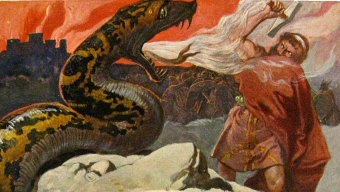Creative ideas from parents:
Create a poster of the gods. Watercolor a huge Yggdrasil tree and then I drew and scanned in a male figure and female figure on the computer to print out many copies of each. He could have probably drawn the figures individually, but he was struggling with perfection at the time and this way he only needed to add the individual features for each god or goddess (hair color, clothes, what they were holding.) As we went through the stories, he colored and cut out the god or goddess we had read about, then pasted them onto the poster with their name. He then drew lines connecting them (i.e. man/wife, parent/child, etc.) but now that I look at it, that part is real confusing since they connect in so many ways. btw, my younger one was also a first grader at the time and he ended up doing his own poster as well.
Also there are a lot of great books for Norse Mythology – I think they are listed in Path of Discovery – and rather than picking just one, we borrowed them all and enjoyed comparing the variations each story (and even the god’s names) would take. Since I didn’t have the time to read each story with him (and since Corey is a voracious reader) I would only read one version with him, then he would narrate others to me, building story telling and memory skills. I just checked his main lesson book and I suppose the other reason I had him narrate so much is he
{+++}
wasn’t much into writing at the time – he has one page telling the story of Odin and an illustration of the great hall of Valhalla – you know, soldiers, swords and weapons – a boy’s dream drawing 😉
Recently my Anthroposophical study group has read “The Mission of the Individual Folk Souls (in relation to Teutonic Mythology)” by Steiner. This lecture series deals in great depth about the significance of Norse mythology in the spiritual development of humanity. It gives me goose bumps! But I do not recommend this lecture series because its translation is pretty odd in important places and it is also pretty hard-core anthroposophy and therefore not so easy to wade through! But for the person who is interested in it, it is a feast.
In my teacher training, the presentation of Norse Myths was very straightforward–introduce the main characters in the regular 3 or 4 week block, along with the usual main lesson book work with illustrations and writing. In the fourth grade, my understanding is that you can still have the child do copying of your own writing or you can do some dictation or have him/her try free writing of the presented material if ready. After the big intro then Norse mythology can be continued throughout the year in story/reading form without necessarily working through it in the main lesson book.
I have know some teachers to get into the poetic Edda or some lines of the Kalevala, which looks good in a main lesson book, but I didn’t get into that part of it myself. As you have mentioned, there are some wonderful form drawings that can go along with the whole thing.
I have two books of plays for Waldorf schools that have Norse plays. one is “Thor, the Bride” by Arthur M. Pitts and is in the book “Pedagogical Theatre” by Arthur Pitts. It is put out by AWNSA. Also in this book is “The Lay of Baldur’s Doom.” The other is “Thor, with Giants” and is in “Plays for Children and Communities” by Eugene Schwartz. The Thor plays are funny. I can’t say for sure if they can be scaled down to a family, but with some flexibility I don’t see why not!!!
My current favorite resource is the Padraic Column book. The main challenge I see is if you want/need to pare down the stories it can be hard to decide what not to do, but that is usually the case with Waldorf main lesson blocks and it only gets harder as you go up in the grades!!
Listen to Scandanavian music. Especially if you can find anyone doing the Finnish kurning (not sure of spelling) which is an incredible experience to hear – very evocative and haunting. You can buy a CD (e.g., “Kalevala” sung by Ruth MacKenzie which includes kurning) – but “live” would be a treat.
There is a new PBS documentary on the Vikings that you could watch for – it really unhinges the stereotype of Vikings as marauders.
Visit the marvelous Viking exhibit when it comes to a museum near you.
FOURTH GRADE NOTES
- Padriac Column’s “Children of Odin” (library)
- D’Auelaires “Norse Gods” (library)
- Book of Norse Lullabies (library)
- Cut-Out Model of Viking Ship (published by British Musuem)
- Idea from someone ( I think a Waldorf teacher): Tell (or read?) Ursula Synge’s “Kalevala” (the Finnish epic) during math blocks.
Verse that often precedes Eurhythmy in 4th grade:
Steadfast I’ll stand in the world,
With certainty I’ll tread the path of life
Love, I’ll cherish in the depths of my being;
Hope shall be in all my doing
Confidence I’ll impress into my thinking
Kytka Recommends:





















